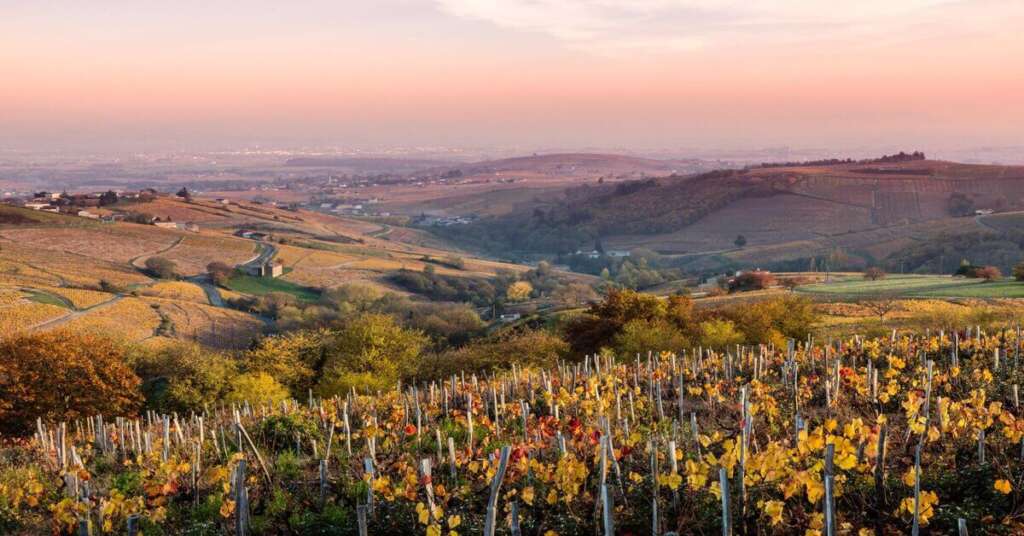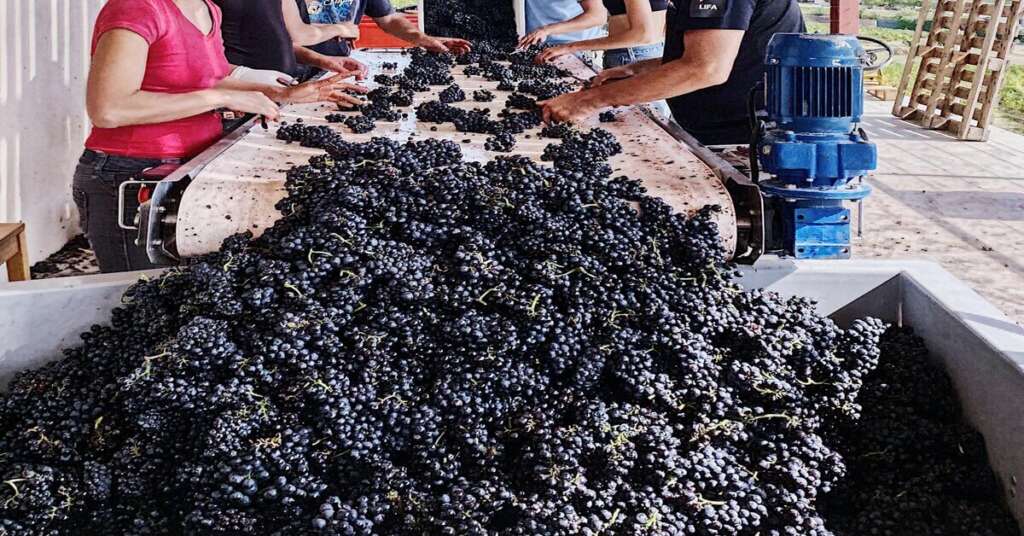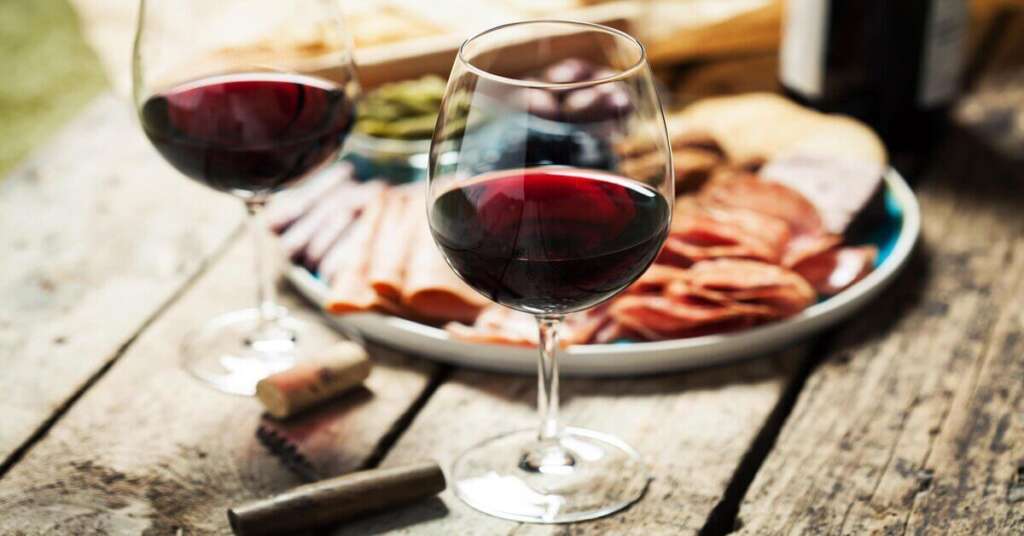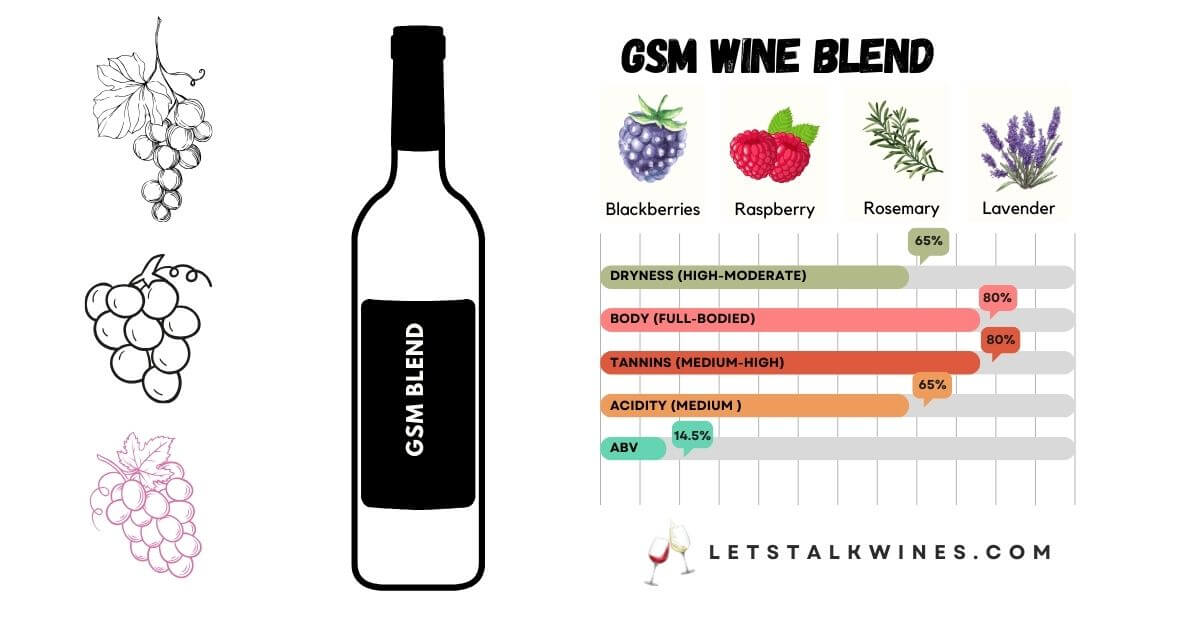A GSM wine is a red wine blend made primarily from Grenache, Syrah, and Mourvèdre grapes. These hearty red grapes are commonly grown in the Rhône Valley region of France and in other Mediterranean climates around the world.
GSM stands for:
Grenache – The base grape that makes up the largest percentage of the blend, typically 30-70%. Grenache is light in color but brings sweet fruit flavors.
Syrah – The second most common grape, typically 15-40% of the blend. Syrah brings dark color, aging potential, and savory, peppery notes.
Mourvèdre – Usually 5-30% of the blend. Mourvèdre contributes earthiness, structure, and acidity.
GSM blends born in France’s Rhône Valley. Winemakers there have been mixing these grapes for ages! Now, GSM blends are popular all over the world, like in Australia, California, and Washington. They’re loved by many wine lovers!
Characteristics of GSM Wines
So what does a typical GSM wine taste and smell like? Here are some of the key characteristics:
Color – GSM blends range from medium to deep garnet hues. The exact shade depends on the percentage of each grape used.
Aroma – Aromas may include red and black fruits like raspberry, blackberry, plum, and cherry. Spice notes like black pepper, anise, baking spices, and leather are also common.
Flavor – On the palate, GSM is typically medium to full-bodied with mouthfilling fruit flavors and soft tannins. Flavors include raspberry, plum, boysenberry and sometimes notes of violet, garrigue, pepper, earth, and leather that add complexity.
Acidity – GSM has moderately high acidity thanks to the Grenache and Mourvèdre grapes. This brightness balances the fruit and gives the wine a food-friendly profile.
Tannins – Moderate fine-grained tannins add structure but don’t overpower the fruit. The tannins become softer and more integrated with bottle aging.
So in summary, GSM blends express fruity Grenache flavors bolstered by the savory, peppery qualities of Syrah and earthy, sturdy structure from Mourvèdre. Top examples will have balance and complexity with no single grape dominating the blend.

History & Origins
GSM blend wine as we know them today originated in France’s southern Rhône Valley, one of the oldest and most prestigious wine regions in the world. The Rhône Valley has a hot Mediterranean climate perfectly suited to ripening Grenache, Syrah and Mourvèdre.
Winemaking in the Rhône dates back over 2,000 years to when Greek settlers first cultivated vineyards in the area. By the Middle Ages, the region was already gaining acclaim for its wines. Several papal decrees protecting the vineyards testify to Rhône’s valued status in Medieval times.
For centuries, Grenache, Syrah, Mourvèdre and other Rhône varietals have been blended together in a variety of combinations. Over time, vintners found the palate of flavors and structure provided by focusing on blends of Grenache, Syrah and Mourvèdre to be exceptional.
Eventually, these GSM blends became associated with the prestigious appellations of Châteauneuf-du-Pape and Gigondas. From this pedigree, GSM’s popularity spread to winemakers abroad looking to emulate the complex yet approachable wines of the Rhône.
Nowadays GSM blends are made worldwide from California to Australia. Yet when it comes to classic old world examples, the original Rhône Valley appellations such as Châteauneuf-du-Pape and Gigondas still set the gold standard.
How GSM Blends Are Made
On paper the GSM blend sounds simple – just mix these three grapes together and you’re done! In reality, creating a balanced GSM blend requires precision and expert judgment from the winemaker.
Here is an overview of how GSM blends are crafted:
1. Grow Grapes in ideal Mediterranean Climate
The Grenache, Syrah and Mourvèdre grapes were born in the hot, dry Mediterranean climate. To achieve quality fruit, these varietals need plenty of sun and heat, cooled off at night by ocean breezes or mountain air. Minimum rainfall ensures the grapes stay small and concentrated in flavor. Vineyards often have poor, stony soils that stress the vines.
2. Harvest Grapes at Peak of Ripeness
Timing harvest correctly is crucial. Grenache ripens first, followed by Syrah and then late-ripening Mourvèdre. To get optimal ripeness across all three, vineyards may harvest in several passes or mix early/late-harvested fruit.
3. Crush & Ferment Fruit
After harvest, the grapes are usually destemmed, crushed and fermented together as a blend. However, in some cases they undergo separate fermentations and are blended later. Extended skin contact during fermentation extracts phenolic compounds including anthocyanins for color and tannins for structure.
4. Age in Oak Barrels
After initial stainless steel tank aging, GSM blends often spend 1-2 years aging in small French oak barrels. This adds flavors of spice, vanilla and toast while smoothing out the tannins. Neutral, well-used barrels are favored to let the fresh fruit shine.

5. Blend Components
Determining ideal grape proportions is critical. Grenache brings sweet berry fruit and body, Syrah adds color and peppery flavor while Mourvèdre gives structure, darkness and earth. Blend ratios vary hugely – From 70% Grenache/15% Syrah/15% Mourvèdre to equal parts of each grape.
6. Additional Aging
After the final GSM blend is assembled, wines see additional bottle aging for 6 months to several years before release. Over time flavors meld together more harmoniously while tannins soften, allowing the wine’s full potential to be realized.
As you can see, while Grenache, Syrah and Mourvèdre seem like natural partners, considerable skill goes into uniting them into a balanced GSM blend. Next let’s examine Rhône Valley’s pinnacle wines made from GSM – Châteauneuf-du-Pape and Gigondas.
GSM in Châteauneuf-du-Pape Blends
Châteauneuf-du-Pape (“Pope’s New Castle”) is a famous wine region in France. For centuries, it’s been known for its top-quality wines, even back in the 14th century when Popes lived nearby!
Today, Châteauneuf-du-Pape allows winemakers to mix up to 13 grape types, but the most important are Grenache, Syrah, and Mourvèdre.
- Grenache adds sweet raspberry flavors.
- Syrah brings in blueberry notes and structure.
- Mourvèdre adds earthy, savory tastes.
Other allowed grapes fill out the flavor and make the wine smoother.
Châteauneuf-du-Pape has strict rules to ensure high quality. This results in full-bodied, complex wines that age well – a perfect example of what GSM blends can do!
Some top Châteauneuf-du-Pape producers are Château de Beaucastel, Le Vieux Donjon, Clos des Papes, and Chateau La Nerthe. If you see these on a wine list, you’re in for a treat!
GSM Shines in Gigondas Blends
Up north from Châteauneuf-du-Pape, Gigondas also makes great wines using Grenache, Syrah, and Mourvèdre grapes. Generally, Gigondas red wines are known for being fruitier and having more floral scents compared to their Châteauneuf neighbors.
Typical Blend: 75-85% Grenache blended with Syrah and Mourvèdre
Limestone ridge soils lend fresh acidity to Gigondas, keeping wines from seeming heavy. Like Châteauneuf-du-Pape, regulations in Gigondas dictate quality standards for maximum yields, alcohol levels and aging before wines are sold.
Standout producers include Domaine Brusset, Domaine Santa Duc, Bosquet des Papes, and Clos du Joncuas. Their top wines can rival Châteauneuf-du-Pape in complexity. In fact, Gigondas has been called “Baby Châteauneuf” for providing excellent GSM drinking at a more affordable price point in their youth.
GSM Blends Around the World
Famous wines like Châteauneuf-du-Pape and Gigondas made Grenache-Syrah-Mourvèdre blends popular worldwide. Winemakers in sunny places like California and Australia started making their own “GSM” wines, often sweeter and fruitier.
California: Hot days and cool nights in Paso Robles and Central Coast make GSMs with lots of berry fruit. Qupé, Tablas Creek, and J. Lohr are some top producers.
Australia: Barossa Valley and McLaren Vale offer deep, chocolatey GSMs with Shiraz (Syrah) and Viognier sometimes added. Yalumba, Mitolo, and Two Hands Wines are worth trying.
Spain: Priorat and Montsant use Garnacha (Grenache) with Syrah for powerful, mature GSMs. Alvaro Palacios and Clos Mogador are leading the way.
South Africa: Warm Western Cape produces GSMs with spicy Syrah and Mourvèdre, sometimes with Viognier. Look for Mullineux & Leeu Family Wines.
While GSM blends thrive worldwide, the original French Rhône blends are still considered the best examples.
Tasting GSM Side-by-Side
Want to experienceclassic old world vs. new world GSM differences yourself? Consider picking up a mature French Rhône GSM from Châteauneuf-du-Pape or Gigondas and compare with a fruit-forward Paso Robles GSM from California.
Tasting them side-by-side lets you compare regional stylistic differences. You’ll quickly notice the depth, complexity and savory elements achieved by Grenache and Syrah when grown in their Rhône homeland.
When swirling your glass, Old World Rhône GSMs showcase exotic garrigue scents – A wild aromatic mixture of lavender, thyme, rosemary and earth that perfumes the wines. These tantalizing scents mingle with red/black berries, baking spices and cured meat notes on the nose.
The palate sees kirsch liqueur flavors complicated by peppery Syrah and granitic minerality. Robust dark fruit is framed by lively acidity and supple tannins – Offering balance despite the wine’s overall power and intensity. Extended aging potential means flavors become more harmonious and intricate over 5-10 years or longer in good vintages.
In contrast, New World GSMs accent sweeter jammy fruit instead of savory aromatics. Think cassis, raspberry preserves and cherry pie filling on the nose and palate. These wines offer gratifying upfront drinking pleasure with softer tannins but usually lack the complexity to age long-term.
Pairing Food with GSM Wines
Alright, these wines get me fired up enough without food in the mix! But friends, let me testify…putting tasty GSM vino together with good eats? slides praise hands emoji
Some may insist on fancy-pants pairings to “properly” enjoy GSM reds. Leave that pretense behind, baby! GSMs made for kicking back and enjoying life’s simple pleasures.
Juicy fruit flavors beg for meat fresh off the grill. Peppery spice and savory notes pump up pizza, pasta – even cheese and charcuterie. Mellow tannins let the convo flow across the entire meal without bullying your taste buds.
In other words? GSM prepares to get down with all your favorite foods! Let your intuition guide you to what sounds damn tasty:
🔥 Fire up the Barbie for juicy burgers, sizzling steaks, smoky ribs, sausages…if it’s chargrilled, GSM complements those complex flavors!
🍝 Pasta Night = GSM Night! Whether meatballs, bolognese, lasagna – paint your plate red with tomatoes, meat and wine!
🍕 Pizza Pal for mushroom, sausage, pepperoni or savory veggie pies. GSM equally at home with thin crust or deep dish!
🧀 Cheese & Charcuterie because GSM has enough personality to not bore.
🥘 Hearty Stews, Chili and Curries let GSM’s berry flavors shine while spice and earth elements keep up.
Here are some more tasty food matches to try with a GSM blend:
- Grilled steak or hamburgers
- Lamb chops or meatballs
- Chicken or eggplant Parmesan
- Ratatouille
- Beef or lamb stew
- Barbecue ribs, tri-tip or sausages
- Rich pasta dishes like lasagna
- Hard aged cheeses
See what I mean? GSM races ahead of the typical wine pairing “rules”. They flex baby!
Bottom line – tasty wine calls for tasty food. Don’t overthink it! Choose flavors that whet your appetite and fill the glass with delicious GSM juice! Life’s too short not to follow your cravings.

How to Buy Quality GSM Wines
Now that you’re a GSM convert, you’ll want to stock up on bottles! Here is a quick guide to selecting quality Grenache-Syrah-Mourvèdre wines:
Seek Out Classic French Regions
For quintessential old world examples, look to Rhône Valley appellations like Châteauneuf-du-Pape, Gigondas, Vacqueyras or Lirac. Vinsobres is an underrated source too. The steep granitic slopes here nurture amazing GSM grapes.
Research New World Regions Excel with Rhône Grapes
In the Americas, California’s Paso Robles region is your best bet for quality GSM blends evoking an old world spirit. Parts of Chile or southern Australia also produce interesting GSMs.
Check Alcohol Levels
For balanced GSM blends, favor wines with 13.5-15% ABV alcohol. Higher than 15% and overly ripe jammy flavors may dominate. Lower ABV could signal weak flavor concentration.
Seeking Ageability?
Top French Rhône GSM blends from strong vintages can evolve positively 5-15+ years. New world GSMs are best enjoyed within 5 years while fruit flavors are fresh.
Consult Reviews from Quality Critics
Well-made GSMs consistently earn praise from critics. Search ratings sites for wines scoring 90+ points on a 100 point scale to find best bets.
Set a Realistic Price Range
Good GSM starts around $25-30. From $40-60, Rhône blends get excellent showing subtle complexity. Over $60 lies the domain of legendary wines like Châteauneuf-du-Papes from prized vineyards.
Following these tips will help you secure satisfying Grenache-Syrah-Mourvèdre wines to pair with your favorite hearty cuisine. Over time and tasting trials, you’ll zero in on your personal favorite GSM producers and regions too.
Popular Variations on GSM Blends
While Grenache, Syrah and Mourvèdre form the crux, winemakers often add supporting players that tweak the flavor profile. Here are some common spin-offs:
GVSM – V stands for Viognier added. Just 1-3% of this white grape contributes exotic apricot aroma and floral lift without diluting the color. Northern Rhône reds like Côte-Rôtie started this tradition that spread to GSM blends abroad.
GSMM – An extra M means more meaty, tannic Mourvèdre (thus the two Ms) which adds brooding darkness and structure. This style shines in Bandol, France.
SCM – Losing Grenache, Syrah takes the lead in these spicier, bolder medium-bodied blends with Carignan. Look for Vieilles Vignes SCM from Priorat, Spain.
SM – Stripped down but still lovely, this two-grape combo spotlights Savory Syrah and sturdy Mourvèdre. Found in Australia under names like Innocent Bystander Syrah Mourvèdre.
There are endless possible permutations of blending Grenache, Syrah and friends. In skilled hands these special combos create such as amazing thing!
FAQs about GSM Wines:
Is GSM a good wine?
“Good” is subjective! GSM wines offer a wide range, so it depends on your preferences. They typically have fruit-forward notes, medium body, and balanced acidity. Explore different regions and styles to find one you enjoy.
Is GSM a Bordeaux blend?
No. GSM stands for Grenache, Syrah, and Mourvèdre, while Bordeaux blends typically combine Cabernet Sauvignon, Merlot, Cabernet Franc, and sometimes Malbec. They come from different regions with different styles.
Is GSM medium bodied?
Yes, generally. While ranging from light to full-bodied, most GSM blends fall into the medium category, offering a satisfying mouthfeel without being heavy.
Are GSM wines dry?
Yes, typically. They usually have low residual sugar, resulting in a dry taste. However, dryness can vary within the style. Look for specific information on the bottle or consult a wine expert.
What is the difference between GSM and Shiraz?
Shiraz is a grape variety, while GSM is a blend that includes Shiraz alongside Grenache and Mourvèdre. Shiraz-dominant GSMs often have bolder body and spice compared to blends with higher Grenache content.
Is GSM a Rhône blend?
Yes! GSM is the classic blend of the Southern Rhône region in France, known for wines like Châteauneuf-du-Pape and Gigondas. However, GSM blends are also produced in other regions worldwide, offering diverse styles.
Last Call! GSM Rambles Home
Well shoot, the sun fading means this boozy GSM party winding down! We laughed, we loved. You rode shotgun while I waxed poetic on Grenache/Syrah/Mourvèdre’s luscious appeal.
Hopefully you feel my fire-in-the-belly passion for this sensational, classic blend. And maybe – just maybe – I’ve inspired you to grab your own sexy red bottle blending fruit spice and harmony.
At the very least, I pray my good ol’ Southern rambles on central Rhône nobility of Châteauneuf-du-Pape and down-home charm of Gigondas played on your heartstrings enough to try them.
And wherever your wine wanderlust takes you seeking GSM – scribble down names of them favorites you come across! The thrill of the chase don’t stop, baby.
Now if you’ll ‘scuse me, all this white hot GSM-love got me working up mighty thirst. I’m on the hunt for my next redheaded soulmate to waltz home with! Y’all keep sipping and smacking lips happily now – cheers! 🍷



